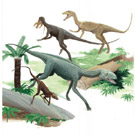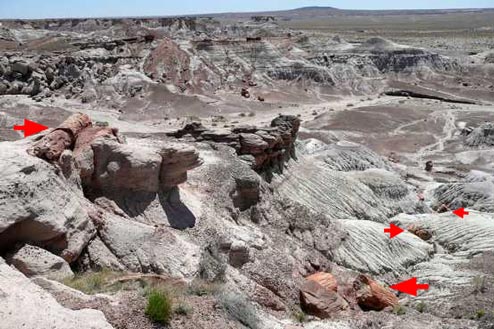Early Dinosaurs of North America Pushing the Date back 11 Million Years According to New Research
New Research Suggests Dinosaurs were Living in North America Earlier than Previously Thought
A team of researchers have used radiometric dating of zircon crystals to determine that the first dinosaurs lived in North American more than eleven million years earlier than previously thought. Publishing their work in the scientific publication “American Journal of Science”, the Massachusetts Institute of Technology (MIT) scientists state that the uranium to lead decay ratios recorded in the zircon crystals indicate that there were dinosaurs living in North America as early as 223 million years ago (Carnian faunal stage of the Upper Triassic).
Dinosaurs
In addition, the team have demonstrated that these earliest dinosaurs coexisted with close non-dinosaur relatives, as well as significantly more evolved dinosaurs, for more than 12 million years. To add to the mystery, they identified a 16-million-year gap, older than the dinosaur-bearing rocks, where there is either no trace of any vertebrates, including dinosaurs, in the rock record, or the corresponding rocks have eroded away.
During the Triassic period, most of the land masses we now know today were joined together to form a single, super-continent (Pangaea). It had been thought that the Dinosauria evolved in the portion of this landmass that ended up becoming South America. Fossils dated to around 228 million years ago from Argentina indicate the presence of small, theropod dinosaurs (Eoraptor), however, the “Dinosaurs evolved in South America” theory has recently been challenged after the discovery of fragmentary fossils in southern Tanzania that may date from as early as 240 million years ago.
To read more about this: The Oldest Dinosaur?
The Earliest Dinosaurs
Lead author of the paper, Jahan Ramezani, a research scientist at the Department of Earth, Atmospheric and Planetary Sciences (MIT), stated:
“Right below that horizon where we find the earliest dinosaurs, there is a long gap in the fossil and rock records across the sedimentary basin. If the record is not there, it does not mean the dinosaurs didn’t exist. It means that either no fossils were preserved, or we haven’t found them. That tells us the theory that dinosaurs simply started in South America and spread all over the world has no firm basis.”
The difficulty we have is that vertebrate fossil records are exceptionally fragmentary from the Triassic and what fossils that have been found such as extensive fossil material associated with the dicynodont Placerias is very difficult to date accurately. Another factor which can confuse palaeontologists is that during the Triassic, a number of archosaur groups thrived and determining which fossils represent an example of a true dinosaur or a crocodylomorph, aetosaur or rauisuchian is a very complicated business.
During the Triassic – All Kinds of Reptile Coexisted
Picture credit: Journal Science
The Chinle Formation
Certainly, parts of Argentina have a more recognisable stratigraphic geology than North America. Plotting the progressive evolution of dinosaurs in the United States is therefore more problematical. However, the research team focused on the Upper Triassic rocks of the Chinle Formation of the south-western United States. This is where the oldest dinosaur fossils from North America can be found. But just how old are they?
The Chinle Formation covers parts of New Mexico, Arizona, Utah and Colorado. It is probably best known for the Petrified Forest National Park location (Arizona), with its extensive fossils of prehistoric trees. Scientists had previously dated isolated beds of this formation, and determined the earliest dinosaur-like animals, discovered in New Mexico, appeared by about 212 million years ago.
Dating Strata at the Petrified Forest National Park (Blue Mesa Location)
Picture credit: Malka Machlus from Lamont-Doherty Earth Observatory of Columbia University
The picture above shows the Blue Mesa locality of the Petrified Forest National Park, a few logs of petrified wood (rust colour) can be seen eroding out of the sun-bleached sandstones (white). We have highlighted the location of some of the chunks of petrified wood using red arrows.
Dating the Formation
Ramezani and his colleagues sought to more precisely date the entire formation, including levels in which the earliest dinosaur fossils have been found. The team took samples from exposed layers of sedimentary rock that were derived, in large part, from volcanic debris in various sections of the Chinle Formation.
In the lab, the researchers subjected the rocks to acids and intense heat in order to break them down and isolate individual microscopic grains of zircon, a uranium-bearing mineral that forms in magma shortly prior to volcanic eruptions. From the moment zircon crystallises, the decay of uranium to lead begins in the mineral and, as Ramezani explains it, “the chronometer starts.” Researchers can measure the ratio of uranium to lead isotopes to determine the age of the zircon, and, inferentially, the rock in which it was found.
This is virtually the same dating technique that was used to help date Venezuela’s first dinosaur Laquintasaura.
To read more about Laquintasaura and what this discovery means: Laquintasaura – What’s All the Fuss About?
MIT Led Research
The study involved a number of researchers from MIT, including co-author of the scientific paper Sam Bowring, the Robert R. Shrock Professor of Geology at MIT. David Fastovsky, (Professor of Geosciences at the University of Rhode Island), also assisted in the research. It seems that dinosaurs, both primitive members of this Order and more advanced forms happily co-existed together for many millions of years. These reptiles in turn, shared the habitat that was to eventually form the southern United States with a wide variety of other archosaurs.
A spokes person from Everything Dinosaur commented:
“The U-PB ID-TIMS zircon geochronology dating method [uranium to lead] is very precise and this team’s study has led to a reassessment of the age of the rocks that make up the lower portions of the Chinle Formation.”
Charting the evolution of the Dinosauria in North America is extremely difficult due to the sparse nature of the fossil record and the lack of firm data to assist with the relative ages of tetrapod fossil bearing strata. This new study prompts a revision of the dating of the Lower Chinle Formation and provided a new temporal context for its rich and diverse tetrapod fauna.
Everything Dinosaur acknowledges the help of MIT in helping to compile this article.



